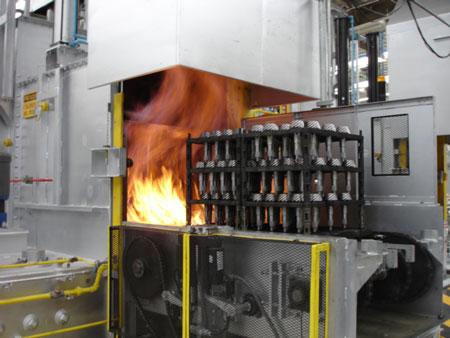Furnace atmospheres are critical to meeting metallurgical specifications defined by control processes. The makeup of a furnace’s atmosphere in the heat-treating process varies based upon the application. In the case of neutral and carbon-rich atmospheres, carrier gas is commonly supplied by an endothermic generator. The endothermic gas provides a non-oxidizing, reducing atmosphere capable of delivering this neutral or carbon-rich atmosphere.
A typical endothermic gas generator supplies an atmosphere using air and a hydrocarbon gas, which are mixed and passed over nickel-bearing catalyst at about 1,900°F. The composition of the endothermic gas will vary based on the component gases and ratios in the mixture. Once the endothermic gas is formed, the gas is cooled to maintain the integrity of the gas composition and delivered to heat-treating furnaces through a header system. Correct cooling of the gas is critical to preventing carbon monoxide from reversing into carbon (soot) and CO2. The cooled gas then forms the basis of the atmosphere used in the heat-treating process. This atmosphere can be measured in a number of ways, most of which are controlled via dew point or an infrared gas analysis to determine the percentage of CO2 in the gas.

The most common method of verifying this endothermic atmosphere is to use a dew point measuring device or an oxygen sensor. (Dew point is the temperature and pressure at which gas begins to condense into a liquid.) The dew point measurement is accomplished by taking a sample of the atmosphere after the cooling process previously described.
One such method uses an oxygen sensor to measure and control the dew point via a calculation in the dew point control instrument itself. This calculation uses the oxygen millivolts generated by the sensor, the hydrogen factor of the controlling instrument (using the assumption of the %H2 in the endothermic gas), and the temperature of the oxygen sensor. The temperature is required for the calculation, but the dew point of the gas is not temperature-dependent. Other direct-measure dew point analyzers typically consist of a capacitive measurement technology providing a voltage output to a controller for a reference to the dew point.
An NDIR three-gas analyzer also can be used to measure the atmosphere in a furnace or generator. The consistency of the endothermic gas produced at the generator significantly affects all downstream processes, and since an endo generator commonly produces gas for multiple furnaces, it is critical to get this process under control. In order for the furnace atmosphere to be controlled consistently and accurately with an in-situ oxygen sensor, it assumes a consistent makeup of endothermic gas. For the endothermic generator gas, values should be 18.8-20.5 for CO, and CO2 should be 0.25-0.50 with a preferred value of 0.40. When a generator is running properly, the dew point in Fahrenheit can be calculated by multiplying the CO2 by 100.
If methane (CH4) has a value of 0.50 or less, the generator is performing correctly. If the CH4 is over 0.50, there may be a problem, and it is advisable to burn out the generator as quickly as the facility can take the generator offline. If after burnout the CH4 climbs back above 0.5 within a week or two, then replacement of the catalyst should be considered. If the catalyst is depleted, uncracked CH4 will be present. As a result, a low dew point (uncracked CH4 is very dry) and an increase in the air ratio will occur. The end result will be a wet gas with soot and water coming out of the generator. Downstream, the furnace will try to compensate by adding more gas, likely creating an uncontrollable atmosphere, preventing the furnace from producing the proper metallurgical results for the parts being heat-treated.
Control parameters on an endothermic generator vary based on age of the equipment and, in some cases, the specifications a heat treater must comply with. Older generators may have only manual controls for the air-gas ratio without the ability to control dew point or CO2. This can be a real challenge based on variations of the composition of air (humidity) and gas (spiking of CH4 from the gas company). Generators can be retrofitted to support automatic control to create a consistent carrier gas.
The latest technology in endothermic generator controls goes beyond just evaluating the composition of the carrier gas. New and retrofitted endothermic generators use sophisticated flow loop algorithms to provide demand-based control of gas generators. Instead of burning off excess unused endothermic gas, these controls evaluate the demand required by the furnaces and automate the precise delivery of gas and air to the generator to provide furnaces with the proper amount of gas at the correct dew point. It provides a low-maintenance, reliable, and environmentally friendly endothermic gas, creating a foundation for producing quality heat-treated parts.

























